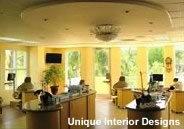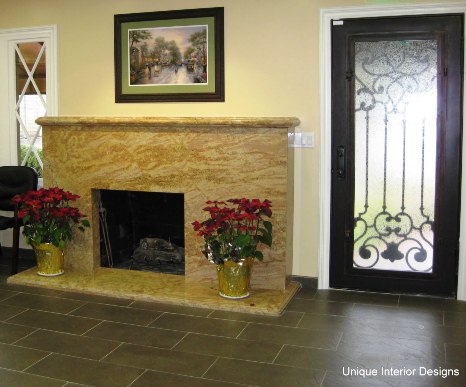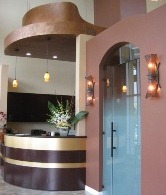We create unique and exclusive dental office designs that enhance your dental practice in 4 important ways ...
Innovative - you will stand out from the rest with a unique and beautiful dental office design that surrounds your patients with a feeling of comfort and inspires a sense of trust and confidence.
Efficient - you'll appreciate an efficiently designed space layout that will significantly improve your productivity and make your dental practice a joy to operate.
Painless - we ensure that you avoid the many complex code, zoning and regulatory pitfalls saving you thousands of dollars and mountains of grief.
Unique - we offer unparalleled service from the beginning to end of your project. No other design firm delivers the level of service we provide.

Smart dental office design is important to your bottom line but building a new dental office today has become a tangle of complexities and pitfalls and many doctors are unaware of the potential problems.
Being in the unique position as an expert in dental office design and with many years experience dealing with city planners, I can help resolve issues that may save you thousands of dollars.
As a Certified Interior Designer with over 1,300 dental offices to my credit, I use a an exclusive customized pre-planning approach that ensures we address the potential issues and design your office to fit your needs, guaranteeing your plans will go through plancheck.
To find out more, be sure to signup for our report "Ten Common Assumptions That Will Undermine a Dental Office Design Project Every Time"! You won't believe how much valuable information we give away for FREE! Get instance access to the report right now, see the sign-up box on the right.
Aug 11
15
Dental Office Design – Don’t Assume You Have Enough Square Footage For Your Dental Office Needs
Next in our series of dental office design case histories that focus on “don’t assume anything“, let’s talk about square footage. We’ll clear up some of the confusion about dental office square footage that can get you into trouble.
Understanding square footage can be a challenge. Square footage terminology like rentable, usable, load factors, common areas refer to some of the different measurements involved in determining how much usable space you actually have available inside your dental office suite.
This common confusion over square footage resulted in a major disappointment for my client Dr. F.
Do You Have Enough Usable Square Footage To Meet Your Dental Office Design Requirements?
When Dr. F. leased his dental office he was under the impression that he had 3,200 square feet within his space. He was quite happy about it as his lease permitted him to sublet some of the space. Since he only needed 2,500 usable square feet he envisioned that he would be able to sublet the remaining 700 square feet and use the income to put towards his lease payments until he needed the additional room.
When Dr. F. hired me to do his build-out plans he showed me the footprint of the space and told me to design only 2,500 square feet. I measured the space as I always do to confirm the actual amount of space we had to work with. Unfortunately I had to give him the bad news. He only had 2,550 net usable square feet.
He was quite upset when he handed me the lease and said “see, it says 3,200 square feet!” After reading it carefully I explained that the 3,200 square feet actually included 650 square feet of common areas. The common areas can include hallways, outside walls and other non-usable space.
In frustration, Dr. F. complained “Why do I have to pay for non-usable space, that makes no sense!”
Posted in Dental Office Design by .
Jun 11
27
Dental Office Design – Don’t Assume A New Property Has The Necessary Underground Requirements
Continuing with our series of dental office design case histories that focus on “don’t assume anything“, in this installment, I want to share with you an example where we discovered an essential underground service was missing and how we handled the situation.
While you never want to assume anything, you can almost always expect something somewhere will go wrong or be amiss. Often times, it’s how you handle and manage these exceptions that define a dental office design success!
Don’t Assume A New Property Has Has All Of The Basic Underground Requirements
Dr. W. purchased a newly constructed condo office. We reviewed his needs, finalized his dental office design, and obtained all of the necessary city approvals. We then had the general contractor begin the building process.
When the contractor started trenching to do the plumbing he realized there was no sewer line in the dental office suite. The contractor and I had reviewed the as-built drawings provided by the condo builder before construction began and it clearly showed a sewer line in the suite, but it was never built.
Posted in Dental Office Design by .
In this next in a series of dental office design examples that focus on “Don’t Assume Anything”, let’s talk about dental office build-out fees. As we’ve touched on many times, hidden fees and unexpected charges seem to pop up all the time. If you’re looking at a new dental office build-out or remodel, always go in with your eyes open, and don’t necessarily accept all of the fees, charges and assessments at face value.
Don’t Assume Your Dental Office Build-Out Fees Are Always Correct
Dr. K was very excited about the new ultra-modern shopping center just built in his neighborhood. He knew this impressive property was exactly the type of place he wanted to locate his new dental office. He set about selecting a space and we began the design phase of the building process.
I was especially happy to work with him on this project because we were going to have some amazingly unique features that mirrored the concept of the shopping center. But the doctor’s excitement began to fade when he received his sewer fee assessment. He showed the sewer bill to me and asked my opinion about why it should be so high. I was really surprised that the fee was over $7,000! This seemed quite exorbitant so I checked into it for him.
Posted in Dental Office Design by .
I hope you enjoy this next in a series of dental office design examples about “Don’t Assume Anything”. This example touches on two mistakes that seem to come up more often than they should.
First is that impulse to grab the lowest price, bid or offer that comes in. We all like the “best deal”, and a dentist office remodel or new office design is no exception. But be careful, the lowest price can often cost you much more in the long run than first meets the eye.
Second, when you’re evaluating new properties and locations to setup your dental practice, you should always have a qualified dental office interior designer or contractor come in and help you review the property before you sign that lease and make the commitment. A professional designer can help you spot many of the hidden problems that the landlord or leasing agent either doesn’t know about or understand.
In fact, this is one of the big mistakes I see dentists make time and time again. I can’t tell you how many times I’ve been called in after the fact to try and fix a situation that could have easily been avoided with a little bit of preventive legwork up front.
Posted in Dental Office Design by .
Jun 11
6
Dental Office Design – Don’t Assume That You Can Build Your Office At The Location You Select.
Another in a series of dental office design examples about “Don’t Assume Anything”. I hope you find this example informative about carefully checking the building codes and regulations for the location that you select.
Don’t Assume That You Can Build Your Dental Office At The Location You Select.
Dr. M. thought she had discovered the perfect location for her new dental office in a strip mall in Los Angeles. There was plenty of foot traffic and the leasing deal was just what she wanted.
She quickly signed the lease and hired me to design her office. However, when I proceeded to get the plans approved by the city I was informed that there wasn’t enough parking for a dental office.
I was confused because the location clearly met current parking code requirements. I researched the records and found that many years prior there had been a ruling that this particular area would be considered to have a special parking variance allowing only minimal parking. The variance stipulated that even the restaurants could only be open at night so as not to use up the parking spaces for an undo amount of time during the day.
Posted in Dental Office Design by .
Although I have been designing dental offices since 1983 and think I have seen every possible challenge that can occur during the design and buildout process, I’ve learned that I can never assume anything. It is important that you’re aware of the potential challenges so that you know what questions to ask before making a commitment.
Another in a series of posts about “Don’t Assume Anything”, I hope you find this example about building codes and disabled access deficiencies informative.
Don’t Assume That The Landlord Knows If The Building Has Disabled Access Deficiencies Or Not.
When it comes a successful dental office design project, understanding the regulations governing disabled access is absolutely critical.
Posted in Dental Office Design by .

 When I kickoff a dental office decorating job with a new client, the process begins with a great deal of discussion looking at different dental office flooring options.
When I kickoff a dental office decorating job with a new client, the process begins with a great deal of discussion looking at different dental office flooring options. If you're setting up, remodeling, expanding or relocating your dental office, don't take another step without obtaining this must-have FREE report.
If you're setting up, remodeling, expanding or relocating your dental office, don't take another step without obtaining this must-have FREE report.